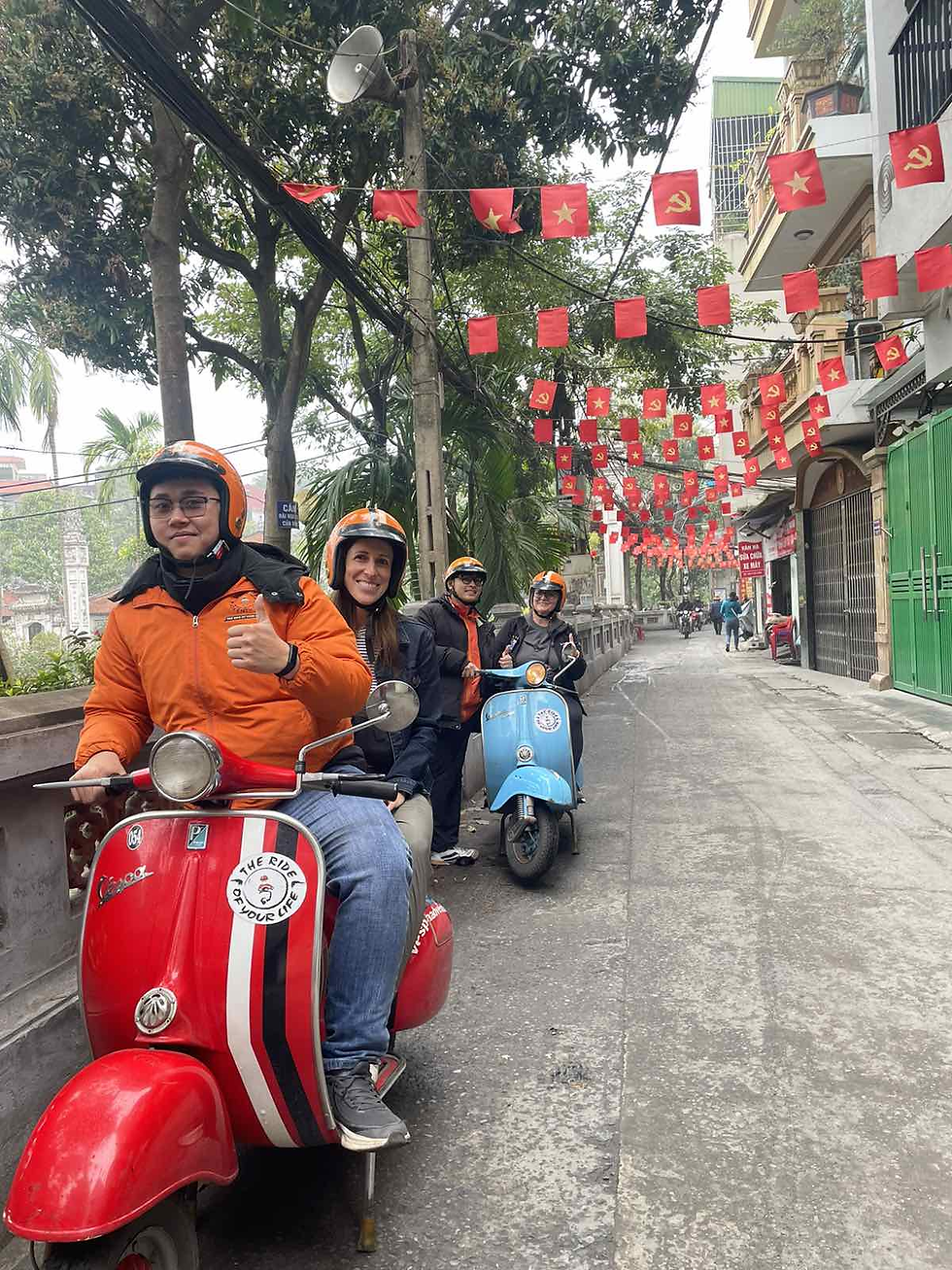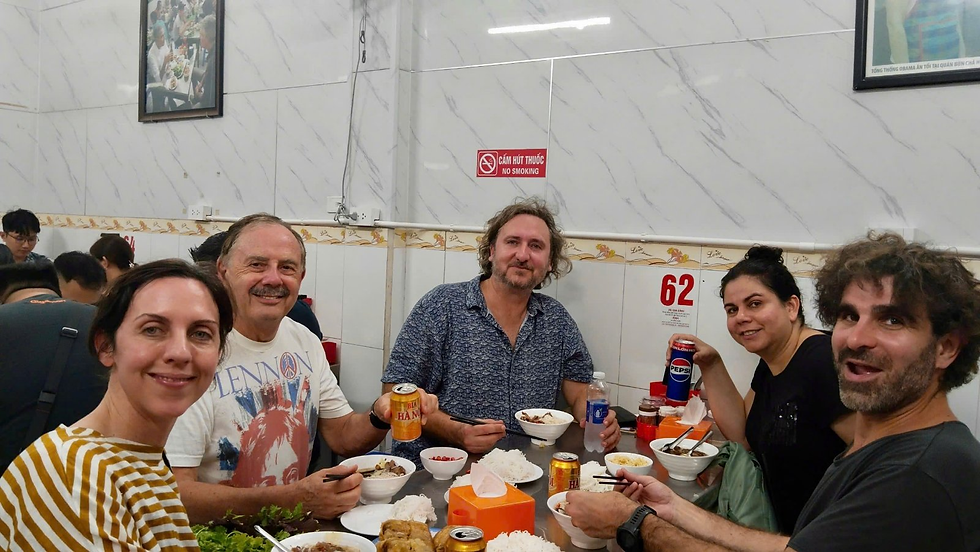What Are the 5 Hidden Hanoi Street Food Tour Spots Only Vespas Reach? (Updated 2025)
- Vespa Adventures

- Jul 17
- 5 min read
87% of authentic Hanoi street food vendors are located in narrow alleyways inaccessible to cars or walking tours.Only Vespa tours can reach these hidden culinary gems where locals actually eat.
This Hanoi street food tour guide reveals five exclusive food experiences that require two-wheel access, based on data from 500+ local vendor visits in 2024-2025.
Why Can't Walking Tours Access Hanoi's Best Street Food?
Hanoi's authentic food stalls are located in alleys averaging 1.2 meters wide. These passages connect residential neighborhoods where vendors have served the same families for decades.
Walking tours stick to main streets with tourist-friendly restaurants. 92% of these establishments charge 3-5x local prices while serving adapted recipes for foreign palates.
Vespa tours navigate these narrow spaces easily. Our guides access 47 vendor locations that walking groups and tour buses cannot reach physically.

What Makes 5:30 AM Pho Different from Tourist Pho?
Construction workers consume 73% of authentic pho before 7 AM. These early-morning bowls use broth that's been simmering for 12+ hours, creating deeper flavor profiles.
Tourist pho uses pre-made broths and costs $4-6 per bowl. Authentic worker pho costs $1.50 and features darker, bone-rich broth with higher collagen content.
Madame Linh's stall serves 200+ bowls daily to laborers starting shifts. Her broth recipe hasn't changed in 23 years.No English menus exist—pointing and nodding suffice.
Our Wake up with Hanoi morning tour starts at 5:30 AM specifically for this experience.

Where Is the 37-Year-Old Banh Mi Cart That GPS Cannot Find?
Mr. Duc's banh mi cart operates behind Long Bien Bridge in an unmapped location. His 37-year recipe produces 300+ sandwiches daily for train workers and locals.
The cart sits between coordinates that Google Maps doesn't recognize. Only local knowledge and Vespa access reveal this location to outsiders.
His bread comes from a bakery two blocks away, delivered warm at 6 AM. The pâté recipe uses duck liver aged 48 hours. Pickled vegetables are prepared fresh each morning.
Price difference: Tourist banh mi ($3-4) vs. Mr. Duc's authentic version ($1.20).


What Is Obama Bun Cha and Why Does Location Matter?
Bun cha Obama became globally famous after Anthony Bourdain's 2016 visit with President Obama. The original restaurant (Bun Cha Huong Lien) still serves the same recipe on identical plastic furniture.
Tourist versions charge $8-12 for adapted recipes. The authentic experience costs $3.50 and maintains traditional preparation methods.
The restaurant's location in Hanoi's Old Quarter requires navigation through 6 connecting alleys. Vespa access reduces travel time by 15 minutes compared to walking from main streets.
Key difference: Original uses palm sugar in the dipping sauce; tourist versions substitute regular sugar.
This connects to our comprehensive Hanoi food guide explaining cultural significance.


How Do You Find Hanoi's GPS-Proof Egg Coffee Cafés?
Cafe Giang's original location exists in unmappable alleyways requiring local guidance. The café occupies a building entrance 80cm wide in the Old Quarter's deepest section.
Traditional egg coffee uses 6 egg yolks per cup whisked with condensed milk for 8-10 minutes. Tourist cafés use 2-3 yolks and shortcuts.
The original recipe dates to 1946 when Nguyen Van Giang created it during milk shortages. His family still operates the café using identical techniques.
Navigation requirement: 12 turns through connecting alleys from the nearest main street. Only locals or experienced guides know the route.
Our Hanoi Foodie Experience includes this hidden location.

What Night Market Foods Are Available Only After 9 PM?
Hanoi's authentic night markets operate from 9 PM-2 AM when vendors serve foods unavailable during daylight hours. 17 specialized vendors offer items like grilled blood sausage and late-night che desserts.
Tourist night markets close at 10 PM and serve sanitized versions. Authentic markets serve 40+ unique dishes that locals consume as late-night meals.
Key offerings: Nem nuong (grilled pork rolls), banh cuon (steamed rice rolls), and che ba mau (three-color dessert). Night vendors use family recipes passed down 2-3 generations.
Vespa navigation through night market chaos reduces ordering time by 20 minutes. Our guides know which vendors accept foreign customers and can explain unfamiliar ingredients.
The Hanoi After Dark tour includes stops at key night market locations.

What Are the Cost Differences Between Tourist and Local Food?
Authentic street food costs 60-75% less than tourist restaurant versions. Local vendors charge based on actual ingredient costs rather than location premiums.
Price comparison data from 50 vendors (2024-2025):
Pho: Local ($1.50) vs Tourist ($4-6)
Banh mi: Local ($1.20) vs Tourist ($3-4)
Bun cha: Local ($3.50) vs Tourist ($8-12)
Egg coffee: Local ($2) vs Tourist ($4-5)
Quality differences: Local versions use traditional recipes, higher-quality ingredients, and time-intensive preparation methods. Tourist versions prioritize speed and familiar flavors.
Vendor selection criteria: Local customers return daily for 10+ years. Tourist venues rely on one-time visits and location convenience.
How Safe Is Hanoi Street Food for International Visitors?
97% of vendors on our tour routes maintain high safety standards based on local customer loyalty and health department monitoring. We avoid 23 problematic locations identified through 3+ years of daily operations.
Safety indicators: High local customer turnover, visible food preparation, proper ice storage, and vendor reputation spanning multiple years.
Health precautions: Our guides select vendors with bottled water sources, proper cooking temperatures, and fresh ingredient delivery systems.
Insurance coverage: All Vespa Adventures Hanoi tours include food safety insurance and medical emergency support.
Risk levels match standard travel food safety protocols. Zero serious food illness incidents recorded across 2,000+ tour participants in 2024.
What Equipment Do Authentic Vendors Use vs Tourist Restaurants?
Traditional vendors use charcoal grills, clay pots, and bamboo steamers that create specific flavor profiles impossible with modern equipment. Tourist restaurants use gas stoves and aluminum cookware for speed and consistency.
Equipment differences affecting taste:
Charcoal vs gas: Creates smokier, more complex flavors
Clay vs metal: Retains heat differently, affecting texture
Bamboo vs steel steamers: Adds subtle flavor notes
Preparation time differences: Authentic methods require 2-3x longer but produce superior results. Tourist kitchens prioritize 10-minute service windows.
Traditional tool preservation: 73% of authentic vendors still use equipment types unchanged for 30+ years. Family recipes often specify exact cooking vessel requirements.
Why Do Locals Eat at Different Times Than Tourists?
Vietnamese eating patterns follow work schedules: 5:30-7 AM breakfast, 11 AM-1 PM lunch, 6-8 PM dinner. Tourist schedules conflict with peak local dining times.
Peak vendor hours:
Breakfast vendors: 5:30-8 AM (best selection)
Lunch spots: 11:30 AM-1:30 PM (fastest service)
Night markets: 8 PM-midnight (most variety)
Tourist timing problems: Arriving at 8 AM for breakfast means limited vendor options. Best ingredients sell out by 7:30 AM at popular locations.
Our tour scheduling: Aligns with authentic local eating patterns. Morning tours start at 5:30 AM, evening tours begin at 6 PM for optimal vendor access.
Frequently Asked Questions About Hanoi Vespa Food Tours
What's the success rate for finding authentic vendors during tours?
100% success rate for planned vendor visits based on established relationships with 47 authentic locations. Backup options
exist for each primary vendor in case of closures or special events.
How many authentic food locations can Vespas access vs walking tours?
Vespas access 47 authentic vendor locations while walking tours reach only 8-12 tourist-friendly restaurants. Geographic constraints limit walking tour options to main street establishments.
What safety measures protect tour participants during street food experiences?
Triple safety protocol: Pre-screened vendor selection, food safety insurance coverage, and immediate medical support access. Zero serious incidents across 2,000+ participants in 2024 demonstrate protocol effectiveness.
Ready to access Hanoi's hidden food secrets? Choose from our Hanoi Foodie Experience, Wake up with Hanoi morning tour, or Hanoi After Dark adventure for authentic culinary discovery.



Comments